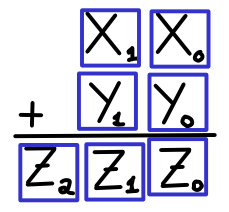Assignment 3
due Monday 4 March in class
Read the pseudo-code below and answer the questions that follow.
step 1. let Y be X + 5 step 2. if Y > 0 then set X to Y * 2 step 3. set X to X * 3 step 4. output XDoes this algorithm contain a conditional statement? If so, which one?
Does this algorithm contain iteration? If so, which steps repeat?
Trace the algorithm with the input X = 4. What does it output?
Trace the algorithm with the input X = -3. What does it output?
Trace the algorithm with the input X = -7. What does it output?
In this problem, you will write down an algorithm to add two-digit numbers in base ten. As shown in the figure, your input variables are X₁, X₀, Y₁, and Y₀. Each variable holds a single-digit integer.

When your algorithm is finished, the answer should be in the variables Z₂, Z₁, and Z₀ – each holding a single digit. For example, if I want to add 56+94, the algorithm will start with
X1 = 5 X0 = 6 Y1 = 9 Y0 = 4and in the end, the Z variables will have the result:
Z2 = 1 Z1 = 5 Z0 = 0Your algorithm should work for any single-digits provided in the input variables.
Here,
Crefers to a sequence of variables (an array), and the notationC[I]uses the value ofIto determine whichCto access.step 1. set K to C[1] step 2. set N to 1 step 3. set I to 2 step 4. if I > 7 then output N then K and stop step 5. if C[I] = K then set N to N+1 and go to step 9 step 6. output N then K step 7. set K to C[I] step 8. set N to 1 step 9. set I to I+1 step 10. go back to step 4.Below are the initial values of the array, and other variables you will use.
K : N : I : C[1] : apple C[2] : apple C[3] : banana C[4] : carrot C[5] : carrot C[6] : carrot C[7] : dateWhat is the output of the algorithm?